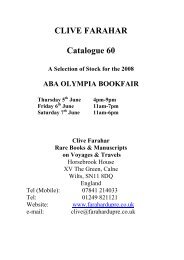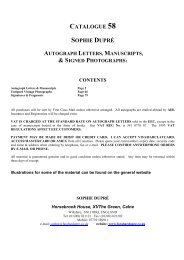You also want an ePaper? Increase the reach of your titles
YUMPU automatically turns print PDFs into web optimized ePapers that Google loves.
Clive Farahar & <strong>Sophie</strong> Dupré, XV The Green, Calne, Wilts, SN1 8DQ, Tel: (01249) 821121 54<br />
391. THOMSON (Sir Charles Wyville, 1830-1882, FRS,<br />
Scottish chief Naturalist on the Challenger )<br />
ALS to the Secretary of the Palaeontographical Society,<br />
saying that he and Dr. Carpenter (W.B., 1813-1885) have<br />
been working on papers for the Philosophical Transactions<br />
of the Royal Society, his own “will form the basis of the<br />
Natural History introduction to the Monog: of the<br />
Crinoids”, which has delayed him giving a firm date, he<br />
now thinks Marsupites belong to the Palaeozoic group, not<br />
Comatula, but will “complete my study of your specimens<br />
and bring them ... to London ... early in Summer”, he details<br />
the contents of the monograph’s three parts, “Comatulae ...<br />
Apiocrines &c. ... and Marsupites”, he may have to get<br />
another artist for the plates, as to his subscription, “A friend<br />
made me apresent of the whole series up to last year and I<br />
cannot afford ... a second, my foreign book account is<br />
necessarily so large”, but discusses back numbers for the<br />
College and himself, he himself would like to start with “the<br />
first part of Salter’s Trilobites”, (J.W., 1820-1869, whose<br />
monograph appeared in the Pal. Soc.’s journal 1864-1867),<br />
7sides 8vo., Strandtown, Belfast, 17th March n.y., c. 1870,<br />
joined at pages 4-5 by old transparent strip, small defect on<br />
side 7 from former laying down [SD50183]£750<br />
Thomson greatly enlarged the knowledge of the ocean floor,<br />
finding living creatures in abundance down to 650 fathoms, many<br />
of which were previously thought extinct, and that deep-sea<br />
temperatures were not so constant as supposed, indicating an<br />
oceanic circulation. His researches were incidentally of great<br />
importance for cable-laying.<br />
See Thomson’s ‘The Depths of the Sea’ (1873) for the dredging<br />
voyages of Lightning (1868) and Porcupine (1869, 1870).<br />
The Challenger Expedition was sent out to make a series of<br />
soundings and dredgings in the three great ocean basins, to<br />
ascertain the temperature and character of the water, to collect<br />
specimens of the fauna and flora on the surface and from all<br />
possible depths, and to study as far as possible certain rarely<br />
visited oceanic islands. The Challenger was a corvette of 2,306<br />
tons, specially fitted up and placed under command of Captain Sir<br />
George Nares, with a naval surveying staff. Thomson, who had<br />
been granted leave of absence by his university, was appointed<br />
chief of the civilian scientific staff (six in number). They left<br />
Sheerness on 7 Dec. 1872, crossed the Atlantic from the Canary<br />
Isles to the West Indies, when after skirting its American side as<br />
far north as Halifax they recrossed to Madeira by the Azores. Then<br />
they sailed southward of the Cape de Verde Islands and St. Paul's<br />
Rocks toFernando Noronha and the Brazil coast, crossing the<br />
southern Atlantic by way of Tristan da Cunha to the Cape of Good<br />
Hope. From this they made for the Antarctic Ocean by way of the<br />
Crozets and Kerguelen land, and reached the ice-pack a little<br />
south of the Antarctic circle, beyond which it was unsafe to<br />
venture in an ordinary vessel. From there they proceeded to<br />
Australia, and after touching at Melbourne and Sydney, sailed for<br />
Fiji. A devious course took them through the Australasian islands,<br />
and then they visited Japan and the Sandwich Islands. After<br />
sailing due south to the tropic of Capricorn, they took an easterly<br />
course to Valparaiso, and made their way into the southern<br />
Atlantic through the Magellan Strait. After calling at Montevideo<br />
they visited the Canaries, and returned to England by a variation<br />
of their former route, arriving at Spithead on 24 May 1876, having<br />
travelled in this remarkable voyage 68,890 nautical miles, and<br />
having made observations by soundings at 362 stations. An<br />
enormous mass of material had been obtained for study, and<br />
Thomson (who was knighted on his return) was appointed director<br />
of the Challenger expedition commission to superintend the<br />
arrangement of the collections and the publication of the results at<br />
the public expense. He also resumed his university duties,<br />
delivered the Rede lecture at Cambridge in 1877, and the<br />
combination of all this work was too much for him and he became<br />
ill and he died at his house, Bonsyde, near Linlithgow, on 10<br />
March 1882.<br />
392. THORNHILL (Cudbert Bensley, d. 1868, Secretary<br />
to the Governor, North West Provinces, during the siege of<br />
Agra, 1857, Commissioner of Allahabad, 1861)<br />
Signed Copy Letter to (Sir) George St. Patrick Lawrence,<br />
1804-1884, Chief Agent (Resident) and Brigadier-General<br />
Commanding in Rajputana, saying that he has seen the<br />
letter of 7th August from Lieutenant (Arthur St. John)<br />
Mildmay, 1823-1884, detailing the assistance given by the<br />
Maharajah of Bikanir and the forces under his personal<br />
command in reoccupying Sersal and Hissar, and enclosing<br />
“a Khureelah expressive of the Lieutt. Governor’s<br />
acknowledgment of the Services of the Maharajah”, to be<br />
forwarded to the latter unless “subsequent circumstances”<br />
dictate otherwise, 1 side folio, Fort Agra, 4th September<br />
1857, afewlight grease marks [SD50021]£75<br />
The letter gives no hint of the current anxiety at Fort Agra, where<br />
the Lieutenant-Governor, John Russell Colvin, 1807-1857, had<br />
gathered all the Christian population of the cantonments and the<br />
city, and, though dangerously ill, had succeeded in preserving<br />
calm.<br />
For Sir George Lawrence’s remarkable services in Afghanistan,<br />
see DNB.<br />
393. TREMATON (Rupert, 1907-1928, Elder Son of<br />
Alexander, Earl of Athlone, 1874-1957, Viscount)<br />
Very fine large photograph, signed ‘Trematon’, showing<br />
him three-quarter length seated, 11” x 9”, n.p., n.d. 1927<br />
[SD14624]£150<br />
Viscount Trematon and his father were Princes of Teck, titles<br />
exchanged for British ones in 1917. His mother, Princess Alice<br />
daughter of Prince Leopold, was the last surviving granddaughter<br />
of Queen Victoria. He died in a road accident in France in 1928.<br />
394. TROLLOPE (Anthony, 1815-1882, Novelist)<br />
Fine unpublished ALS to Charles Banning aying he has<br />
received an "invitation to meet C. Dickens at a dinner to<br />
be given for him at Liverpool ... which I have accepted. I<br />
want to take my son with me ..." and asking if he can secure<br />
a ticket for his son as he feels he cannot ask himself as he is<br />
a guest, 3sides 8vo., address removed, 13th March n.y.,<br />
[1869], the top left hand corner has been torn off with the<br />
loss of the address but no text, professionally repaired<br />
[SD26558]£895<br />
This meeting of the two great novelists is not mentioned in any of<br />
the major biographies of Trollope. The dinner was held in<br />
Dickens' honour on the 10th April 1869 and is briefly noted in R.<br />
C. Terry's 'Trollope Chronology' but seems to have been otherwise<br />
unnoticed by Trollope scholars. It is rare to find letters of<br />
Trollope mentioning Dickens: less than twenty are known. Letters<br />
of Trollope to Banning, a post office colleague, are even rarer:<br />
only one other survives. Trollope at this time was anxious about<br />
his sons making their way in the world. Although both sons were<br />
around -- Fred had just returned from Australia but was intending<br />
to leave England again in late April -- it is more likely it was<br />
Harry whom he wished to introduce to society, perhaps with the<br />
hope that the boy's job prospects would improve as a result. A<br />
few months following this dinner, Harry did indeed secure<br />
employment -- with Chapman & Hall, Dickens' publishers, whose<br />
high-ranking staff would almost certainly have been present at this<br />
dinner.





